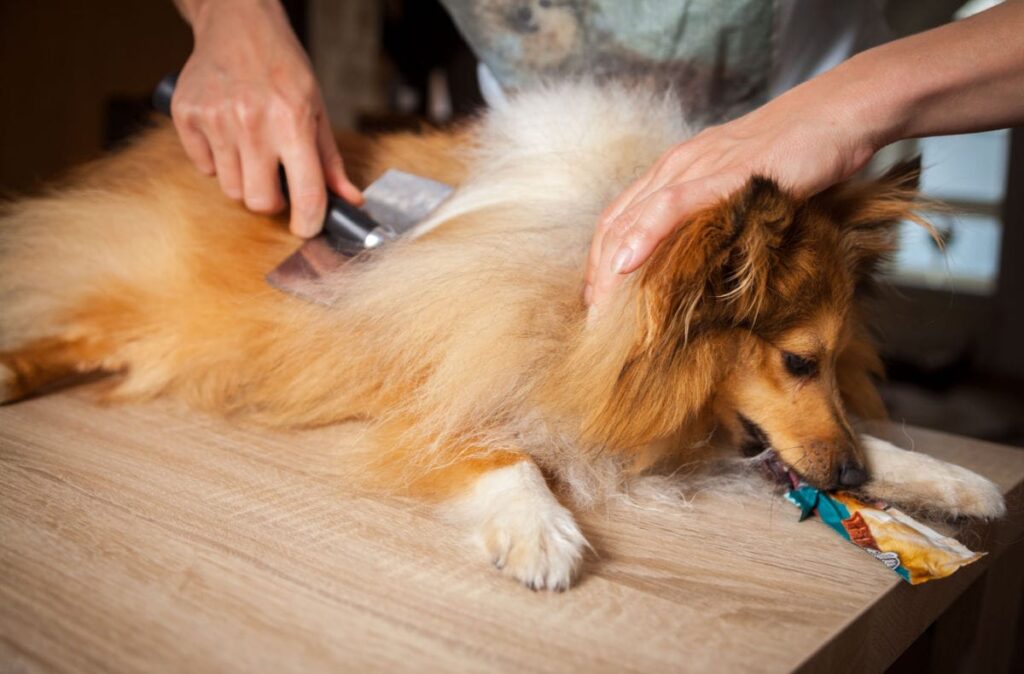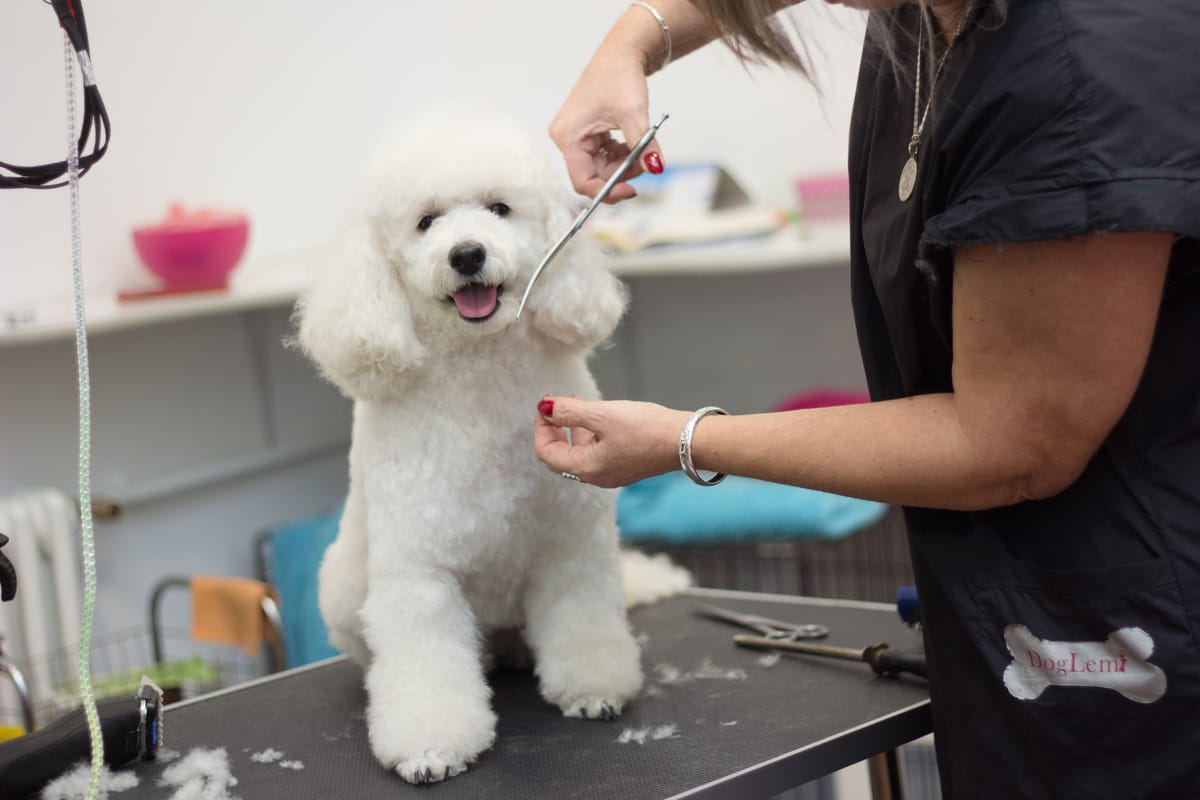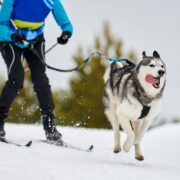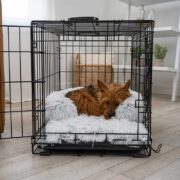If your dog has long hair or certain types of hair, it may get matted from time to time. Matted hair can be a problem because it can interfere with your dog’s normal body functions.
That’s why it’s vital to take a look at why your dog’s hair might become matted, why that’s a problem, and what you can do about it.
Why Does Your Dog’s Hair Get Matted?

When your dog’s fur becomes tangled around itself, it forms a clump of tightly wound fur. If these are not brushed out, the mat becomes more tangled and closer to your dog’s skin.
Matting happens more often in areas where there is friction. For example, around your dog’s neck where his collar sits, in his armpits, under his chin, between his toes, on the back of his rear legs, and where a harness sits are all areas where mats tend to form.
Is There a Time of Year When Mats Form More Often?
The short answer is yes, but that doesn’t mean it happens during just one time of the year. Matting happens more frequently when your dog is shedding. This is when dogs switch from either winter to summer coats or vice versa.
During the shedding season, if loose fur doesn’t get brushed out, it can easily become tangled against the skin. That’s why it’s important to brush your dog regularly when he’s shedding.
Do Certain Activities Form Mats?
Swimming is one activity that can make your dog’s fur more prone to matting. Moisture causes the hair to curl, which makes it easier for it to get wrapped around itself as it dries.
This can also happen if you bathe your dog but don’t brush him out or dry him thoroughly afterward.
Are Certain Dog Breeds More Prone to Matting?

There are some dog breeds that tend to form mats more often than others. Dogs with curly hair, like Poodles or Bichon Frisés, need regular maintenance to prevent matting.
Dogs with a mixture of curly hair and a double coat, like Doodles, are also more likely to mat without proper maintenance. Additionally, certain long-hair breeds, such as Bearded Collies and Rough Coat Collies, also form more mats. It’s easier for that long hair to get wrapped around itself.
What is the Difference Between Mats and Cords?
Certain dog breeds have corded hair, meaning it’s been groomed to form a kind of dreadlock called cords. While it looks like matting, it’s not the same, but dogs with corded hair do need to be regularly maintained to prevent any skin issues from occurring.
The most well-known breeds that have corded coats include the Puli, Bergamasco Shepherd, and the Komondor. Many people will call these dogs “mop dogs,” and the hairstyle was used to disguise them when they were on the job guarding and herding livestock.
Of course, nowadays, certain show dogs may have a corded coat for show purposes. Most of the time, regular pet parents don’t do the cording because it does require extensive maintenance, and you also need to be experienced to form the cords.
Why is Matted Dog Hair a Problem?

If you don’t take care of your dog’s matted hair, it can create a health problem. Extreme cases of matting interfere with the airflow to the skin, and that can cause other health issues. These include cases of pelting.
Pelting is where the mat is very tight to the skin. That can interfere with temperature regulation. Your dog loses body heat through his skin, and when his hair is matted or pelted, the body heat cannot evaporate properly through the skin. That could result in heat stroke.
Another problem that can be created by matted or pelted dog hair is skin irritations like hot spots. These can be very painful and lead to bigger problems.
Matted fur can also hide flea infestations and other external parasites. That’s just one more reason why it’s important to brush mats out before they become pelted and difficult to detangle.
How Can You Prevent Matted Dog Hair?

The best way to prevent matted dog hair is to regularly brush out your dog’s coat. How often you need to do that depends on the coat type and if it’s shedding season.
Dogs that are more prone to matting, like those that have a double coat, curly hair, or long hair, should be brushed more frequently. Some dogs may need to be brushed out every day, while others may only need it once a week.
It’s also important to pay attention to how you’re brushing out your dog’s fur. You want to be sure to get the undercoat as well as the top layer. If you just brush the top layer, you are actually pushing the loose fur and tangled areas closer to the skin.
To avoid just brushing the top layer, you need to use the correct dematting tools, like an undercoat rake or a slicker brush. You can also use a detangling spray or leave-in conditioner to make your job a little easier.
When using a leave-in conditioner, spray it on your dog’s damp coat after his bath. Then you can brush it through the coat to ensure it gets all the way down to the skin.
How Can You Demat Your Dog’s Hair?
If your dog already has mats, it means you need to take extra care. You can try to untangle the mat apart with a comb or something like a slicker brush, but your dog probably won’t like that very much.
Brushing out the mat isn’t a good option unless it’s a very small mat. If you do try that, use some detangling conditioner spray as you loosen it with your fingers. You’ll want to hold the mat at the base to prevent it from pulling on your dog’s skin.
Use small strokes as you brush, and be sure to give your furry friend some treats along the way. You can also use a licking mat that you smear with peanut butter or wet dog food. This will give your dog a positive association with brushing.
What About Using Scissors to Remove a Mat?
One word — no! Don’t ever use scissors to cut out a mat. You are very likely to cut your dog’s skin. If you feel like you need to cut the mat out, it’s better to use grooming clippers.
You want a set of dog clippers with a long battery life if you’re doing this at home since you don’t want to have to worry about the cord. You also want clippers with 5-in-1 blades or changeable blades to allow for different trimming lengths.
When you’re using the clippers, lay the blade’s flat surface against the skin. It may be tempting to turn the blade on its end to get a closer shave, but you can cause skin irritation doing this.
Also, you don’t want to raise your dog’s skin as you trim out the mat. Hold the end of the mat with your fingers and start trimming at the base of the mat, working outwards. Peel the layers of the mat off with the blade.
This technique works well for isolated mats, but if your dog has a more widely matted coat, you’ll need to see your groomer. They can do a full-body trim on your dog, but if your dog has severe matting. your best bet is to see your veterinarian. If necessary, they can even sedate your dog to deal with the issue.
When Should You Use a Professional Groomer?

It’s always a good idea to get regular grooming for your dog to prevent matted fur. This usually means professional pet grooming. Getting this done routinely can make their job a lot easier since they have to clip underneath existing mats, which means they have to cut the hair shorter than what may otherwise be necessary.
Some pet parents don’t want an unnecessarily short haircut, but your groomer may not have any other option. That’s why regular brushing in between groomer visits may also be helpful, particularly if you have a long-haired dog.
It’s important to find a reputable dog groomer who both you and your dog can be comfortable with and who will understand your grooming preferences. Spend some time with them, and feel free to ask questions as you discuss what you would like them to do.
It’s particularly important to discuss what you would like the groomer to do in the case of matting. You may want them to just shave the matted area and leave the rest at your preferred length. If your dog’s mats are limited to certain areas, like the belly or inner legs, that’s easier to do.
The other option would be to have them shave your dog’s hair to the shorter length needed to remove the mat all over his body. That might mean it will be quite short, but it won’t look so spotty.
Whichever you prefer is fine, but be sure your groomer knows what you like and when they should contact you before proceeding. Your groomer can also give you helpful tips on how to manage your pup’s hair between visits. They can also talk to you about using effective, safe medications to prevent fleas and other parasites that can cause or aggravate skin problems.
Final Thoughts
Everyone feels better when their hairstyle is working, and that includes your best furry friend. Mats don’t work, and they can cause health issues beyond just a bad hair day. Regular grooming can help prevent painful mats and skin conditions that often result. So take a spa day with your best friend, and you can both get a new, mat-free do!

